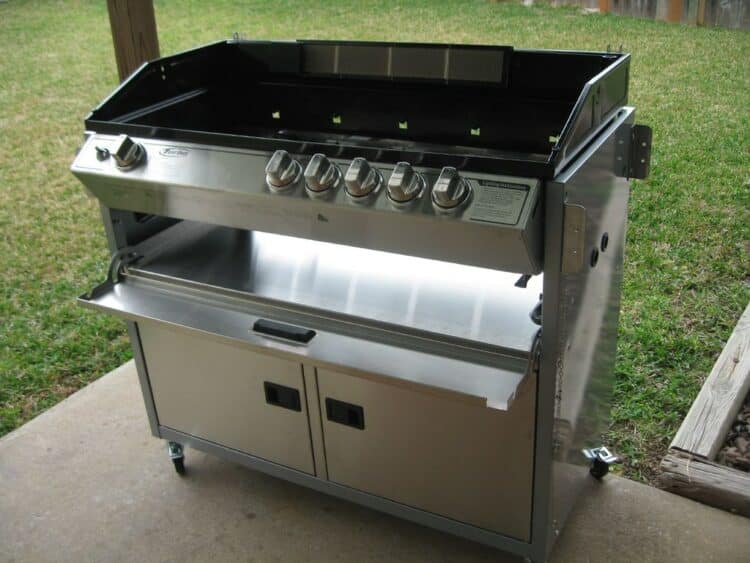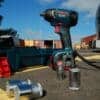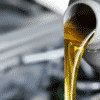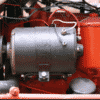
Is your grill igniter not working? You have purchased your gas grill in good working order. However, as time goes by, you notice something iffy with it and is acting up.
When it is functioning as it should be, the flame is bluish with yellowish color at the tip, the fire is disseminated equally throughout the burners, and it should reach speedily to grilling heat when you turn it to the highest setting. The cooking surface should not have a difference in heat.
If you notice something is going haywire with the equipment, like the gas regulator valve not working, then you may have a problem. Before thinking of getting a new one, there are a few things you can try out.
Table of Contents
Knowing how the different components and functions work
Keep your grill in working condition, and do not let it end up in the trash heap. Owning one is a good investment, and it is essential to keep it operating longer without any hitches.
When you are not using it, store it somewhere safe from the elements and provide it adequate coverage. Then clean it up after every usage by washing it thoroughly.
Whether you do take care of it or not, something unforeseen is going to happen. That is why you need to be prepared and know its basic parts and ways of fixing it.
In appearance, your flame mate kitchen equipment is a seemingly complicated device and looks to be intimidating to fix by yourself. Yet, the design has not changed too much from its first inception.
The older models had only one burner, but the newer ones have five at the most. Yet all of them are encased in a steel box, either of an aluminum cast or stainless steel.
The current typical grill has an igniter, a regulator, fittings, and a burner, which is similar to the grills of yesteryears. The gas begins either in a gas line connected to the house or in a propane tank.
The natural gas burner regulator has the task of limiting the gas pressure. Its chief role is for the gas to go through a manifold that evenly separates it from the available burners. Then it flows through the grill valve where the temperature can be controlled and adjusted.
Then the gas goes through the venture tubes to intermix with oxygen so it can cause a fire. Lastly, it passes through the burner and out to the ports to create the flame that you can see.
On newer models, there are types of barriers that assist in correct heat distribution and likewise protect the burner.
Lava rocks were used as barriers for older models, some used ceramic or charcoal briquettes. It can also function to catch food drippings that will be burned by the heat.
If you think there is something wrong with it and you want to take it apart, be sure to turn off the barbecue propane venturi valve from the fuel tank, and the gas line is disconnected. This way, you can avoid any harm unto yourself and to the surroundings.
When something happens which makes it not function to its full capacity, the first thing you need to decide is to either replace it or fix it. It is your preference.
Some newer models are made with a low quality compared to ones made ten years ago. Some manufacturers want to earn more money by taking shortcuts in utilizing inferior construction materials.
Those inferior grade grills usually come cheap, so replacing them will be no problem. For older models, you have many options of finding parts, either online or in local hardware stores.
The way to check if the grill is working the right way is by the flame. When it is distributed equally among the burners, the fire has a bluish color with a yellowish tip. It should heat rapidly on a high setting.
If your grill does not function as mentioned, then there is something wrong with it. To find out what is wrong, you have to know the different parts.
Fuel hose and regulator troubleshooting
What comes out of your natural gas line or propane tank is too much to what you will need for grilling, so the regulator manipulates the gas flow. It is connected to the gas line or the tank by an elastic hose that has an “O-ring” to ensure that the seal will be tight and gas would not leak out.
Regulators are specifically designed by the manufacturer, so you should not attempt to adjust them. There is a small vent at its center. Most of its common issues are clogging, which can cause trouble due to the unpredictable flow of fuel.
The obstructive elements can be cleared up by gently rapping on the vent or blowing powerful spurts.
Another issue that may arise is that the fuel may leak, which can lead to disaster. It is caused by damage to the O-ring or hose. To check if there is no leak, soak a sponge with soap and water and wipe the propane burner control valve to the tank.
In doing this procedure, only the control valves should be turned off while the tank is connected. If you spot a leak due to the bubbles, then the component should be replaced.
Propane venturi tubes
To provide flame for the grill, the broil king venturi tubes are linked to the bbq gas valve, which passes along the burner. It allows mixing air with fuel to create fire.
There is an opening where the fuel and air are mixed, which stuff can enter and become jammed. Insects, like spiders, can enter it and make a nest in the space.
The way to solve this is to envelop the tubes in an aluminum mesh that would not hinder the airflow but will halt the insects from entering. Modern grills already have protection pre-installed in the tubes.
Another recurring problem is the propane venture tubes are not aligned properly to the burner. The tubes tend to be knocked from their position. It has shutters that can be adjusted to fix the problem so that fuel can flow correctly.
Propane tank under grill
In the past, propane tanks did not have safety standards, unlike the modern ones, which have an OPD (Over Fill Prevention Device). This procedure prohibits tanks from filling up beyond capacity. Whenever the OPD is malfunctioning, this enables the tank to no work properly.
Control barbecue gas valve
This component allows for determining the current of fuel towards the burner. Each grill burner is equipped with one valve, which consisted of a few parts made for a specific purpose.
When something happens to the valve, and it becomes defective, the whole unit should be replaced. Before doing it, take out the valve first and examine it. Like the other components, insects like to make a living space out of it.
The central part of the valve is an opening that controls the airflow and can become obstructed. Use a thin piece of wire to remove any unwanted blockage.
After cleaning, be sure to can assemble it back together with the way it was before. Without the central opening, there is no way or controlling the gas flow towards the burner, which can lead to dangers like an explosion.
Multi jet propane gas burner
The burner’s appearance will vary depending on your type of grill. You will also know how durable it is with the kind of material it originated.
It is made from various materials like aluminum, cast iron, or stainless steel.
Inexpensive and low-quality burners like aluminum steel will last about three years, while high-end expensive ones are more durable and last longer.
The wear and tear are caused by its tendency to get coated with food grease, which can cause corrosion. Check on it once in a while for any problems and clean it regularly.
If it becomes too damaged with corrosion, then you have to look for a replacement. Always get the same burner size dimensions, and also think about getting one with higher quality.
Radiant or barrier
There is something in between the iron bars that hold the flame and the burner. Some people call it a barrier and some, a variant. Its main task is to protect the burner from the food drippings and collects grease to disintegrate.
Steel plates, lava rocks, and briquettes are common barriers used in grills. They often need to be replaced because they tend to get burned by grease and food drippings, which can transfer to the food and create a displeasing taste and aroma.
Lava rocks need to be substituted many times over because they are porous.
Metal plates can last for a long time. You only have to clean it often.
Always make it a habit to inspect the barrier. Check if it is heavily greased up, or if it is broken or cannot provide sufficient blockage. If either of the three happens, then replace it immediately.
Practice safety before attempting the power flame burner troubleshooting
When you notice that there is something wrong with your grill and you want to fix it, you need to apply safety precautions first. Be sure to switch off the valve from the tank and unplug it.
If the grill was previously used, give it time to cool down. Let the harmful gas evaporate in the air before beginning to troubleshoot.
Issue #1: Troubleshoot gas grill low flame
This problem usually happens to all grills at some point, and the main culprit is the regulator in the fuel line. It tends to get sticky. When they do stick, it prohibits the steady flow of gas, which would not allow for an adequate temperature for grilling.
To counter this, you need to follow these steps to reestablish the usual flow of fuel:
- Cause the grill lid to open.
- Switch off the gas from the tank.
- Unplug the fuel line from the propane tank.
- Switch all the valves to the highest level.
- Let one minute pass.
- Switch off all the valves.
- Plug in the fuel line back to the tank.
- Slowly and steadily switch on the gas.
- Light it up
- It’s now fixed and the heat is now in the normal grilling temperature.
To disengage the regulator from ever become sticky once more, first switch off the control valve, then do the same with the tank valve and the fuel line. Make it a habit to always turn of the tank valve in a slow motion.
If it still would not work, do the whole process again. In step number five, try to tap gently on the regulator.
If the low flame symptom persists, then the regulator is defective and needs replacement.
Issue #2: Overabundance of smoke on the grill
The chief culprit is the grease, which has steadily increased within your grill. Washing it off will fix it and turn it on for fifteen minutes before any grilling action to incinerate any remaining deterrents.
Issue #3: Flame changes color to orange or yellow
When this happens, examine the venturi tubes and the valves for any blockage and misalignment. Check if the flow of gas is uninterrupted.
The tubes might be not be positioned properly, and the venturi shutters may need to be lined up correctly, so follow these steps:
- Look for the screw on the venturi tube. Unscrewing it will release the shutters.
- Inflame the grill but to the lowest temperature.
- Proceed to turn the screw slowly to loosen, then cause the shutters to open and wait for the flame to turn to a bluish color.
- Switch off the gas and turn the screw again to tighten it.
- Leave the grill to cool.
Issue #4: Heat is not evenly distributed to every corner
The chief cause for an inconsistent heat on your grill is something is blocking the burner. There is an array of openings along the sides of the burner, which emits gas to create a flame.
Food drippings usually trickle down towards the burner and obstruct the openings. A wire brush can scrape out all the sticky leftovers from the burner and let the gas continue to flow uninterrupted.
In some cases, congestion has become so apparent in the burners that you have to take it out from the grill to get it cleaned. With some newer models, you can easily remove the burners by lifting, but others are screwed in, so you need tools to unscrew them.
In cleaning them, do not use strong detergents, which can cause corrosion.
Issue #5: Is your grill igniter not working? Here’s how to fix it
The igniter in your grill is either a push button or powered by a battery. If your grill uses a battery to power the igniter but then would not ignite, then replace the batteries with new ones.
If the push button does not ignite the burner, then either there is something wrong with the wiring or the button is defective. You need to replace the bad parts.
If it still won’t ignite, there may be something blocking it. Remove the steel grates and the barrier so you can check on the burners.
Look for the malfunctioning igniter, then press the button. You ought to hear a series of clinks and see a tiny spark due to the electric start. If it still would not ignite, then clean it carefully and start it again.
After cleaning and it still would not inflame, then it is because the wiring or the switches are defective. You need to replace them.
Issue #6: Fire coming out from below the grill
This issue arises due to the venturi tubes are either blocked or not aligned properly. After grilling, wait for a few minutes for it to cool.
Examine all the grill components if they are tightly fitted together. Observe all the gas lines and hoses if there are any cracks, or maybe burned or melted through. If there are, then they need replacement.
5 steps in rescuing your worn-out gas grill from the trash heap
You can refurbish and transform your beaten-down grill into a brand new condition. All of the components are replaceable and restorable at an inexpensive cost that can last for a long time.
- First, take out the metal grate remove the rocks then set them aside. Clean out all the grease and grime, then repaint with high-temperature paint. You can purchase new replacement parts in any hardware center.
- Is the grill igniter not working? Press the button a few times. If not, then you need to replace it.
- Take apart all the burner components, including the venturi tubes. Proceed to clean them. If some are too rusted, they replace them.
- Use a plastic scraper to scrape all the grease and dirt buildup from inside and outside the grill. Scrub them thoroughly with soap and water.
- If there are wooden slats, you can refinish them by sandpapering and applying Danish or linseed oil. Utilize a rust converter on the grill before spraying on a primer. Reapply a second coat after drying. Once everything is dry, reassemble everything so you can start grilling.


